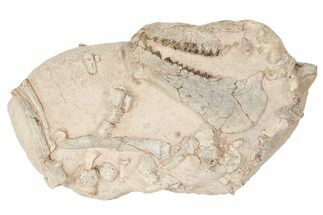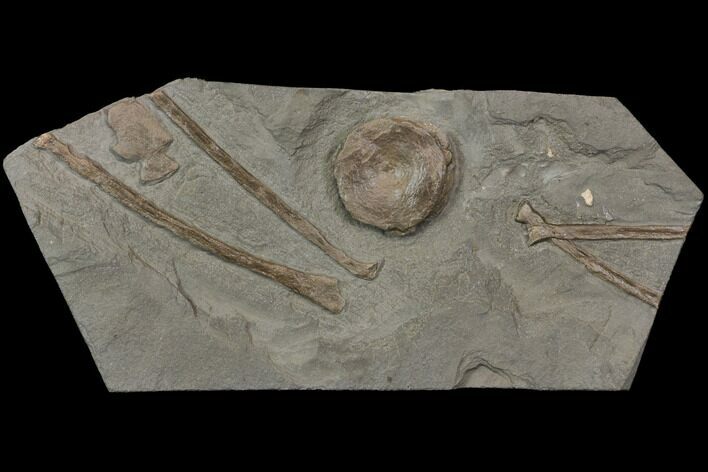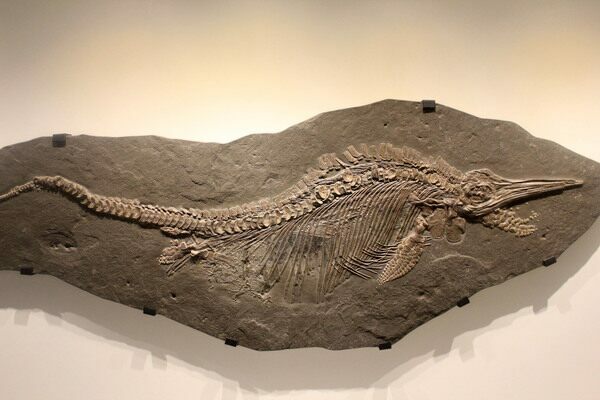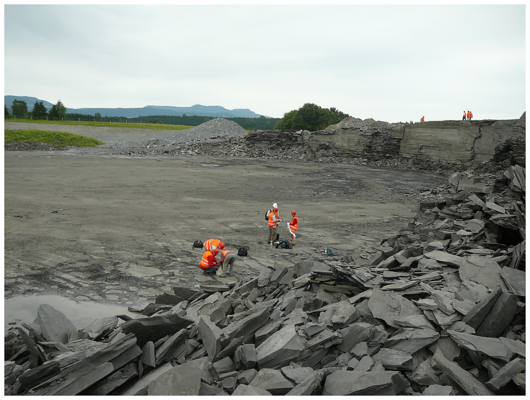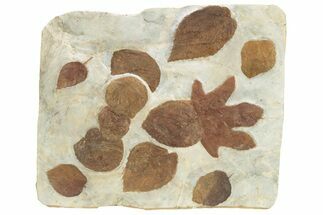This Specimen has been sold.
13.8" Fossil Ichthyosaur Bone Plate - Germany
This is a 13.8" Ichthyosaur bone plate from the Posidonia Shale, Baden-Württemberg, Germany. It contains a vertebra and four rib sections. The ribs all appear to be proximal ends where the ribs engaged the vertebra. The bones are in excellent condition and their dark color stands out nicely against the gray shale.
Comes with a display stand.
Comes with a display stand.
Ichthyosaurs were swordfish-like marine reptiles of the order Ichthyosauria. They had torpedo-shaped bodies with long, narrowly pointed jaws, large pectoral fins, and crescent-shaped tails. They were the high-speed predators of the Jurassic seas, indicating they ate a fish diet. This is confirmed by analysis of coprolites (fossil feces). They evolved about 250 million years ago, hitting their diversity apex during the Jurassic: there are currently 97 known genera. They may be descended from diapsids like dinosaurs and birds, but a recent theory suggests they may have descended from a distant relative of turtles. Ichthyosaurus had disappeared from the fossil record by about 90 million years ago. It is not known why they died out.
Ichthyosaurs are not fish. Their resemblance to them is an example of two groups adapting to their environment with similar adaptations without having a common ancestor, otherwise known as convergent evolution. Ichthyosaurs were reptiles with lungs that had to surface to breathe, while fish have gills that take dissolved oxygen from water. Ichthyosaurs looked like swordfish or dolphins: their bodies were larger near the head and tapered to a sleek, crescent-shaped tail.
Ichthyosaurs had one of the largest eyes relative to body size of any organism. This may allowed them to better move throughout the water column to find prey, reaching tremendous speeds with their crescent tails. Some estimates put the top speed of the fastest species above 30 miles per hour. Like most fish living today, Ichthyosaurus was likely dark colored on its back and sides and light on its belly as a form of camouflage.
Ichthyosaurs are not fish. Their resemblance to them is an example of two groups adapting to their environment with similar adaptations without having a common ancestor, otherwise known as convergent evolution. Ichthyosaurs were reptiles with lungs that had to surface to breathe, while fish have gills that take dissolved oxygen from water. Ichthyosaurs looked like swordfish or dolphins: their bodies were larger near the head and tapered to a sleek, crescent-shaped tail.
Ichthyosaurs had one of the largest eyes relative to body size of any organism. This may allowed them to better move throughout the water column to find prey, reaching tremendous speeds with their crescent tails. Some estimates put the top speed of the fastest species above 30 miles per hour. Like most fish living today, Ichthyosaurus was likely dark colored on its back and sides and light on its belly as a form of camouflage.
The Posidonia Shale (part of the Sachrang Formation) outcrops near the town of Holzmaden in southern Germany have been commercially quarried for centuries. The quarried shale has been used for such things as tile, table tops, and fireplace hearths. These quarrying operations have also uncovered a vast treasure trove of beautifully preserved, Early Jurassic (~183 million years old) fossils. The lower shale layers have even produced world-class ichthyosaur fossils with preserved skin and soft tissue impressions.
SPECIES
Unidentified Ichthyosaur
LOCATION
Ohmden, Baden-Württemberg, Germany
FORMATION
Posidonia Shale Formation
SIZE
13.8 x 6.1 x .9"
CATEGORY
SUB CATEGORY
ITEM
#114196
We guarantee the authenticity of all of our specimens.
 Reviews
Reviews

